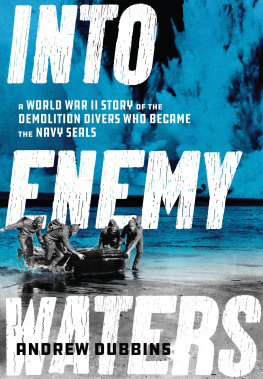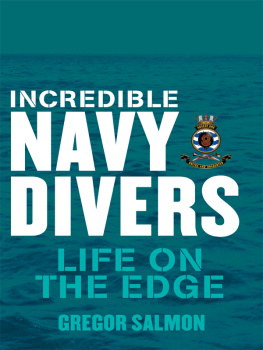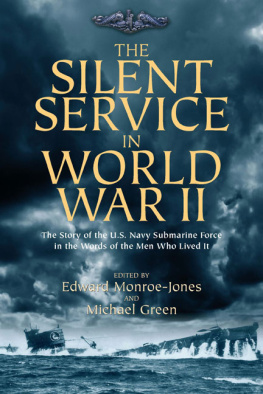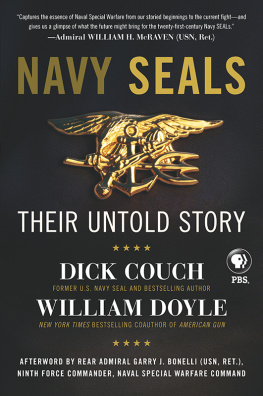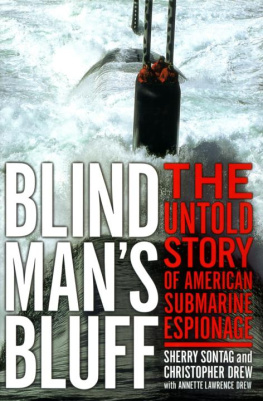ACKNOWLEDGMENTS

A work of nonfiction like this one would have been impossible to write without the cooperation of many people, especially those whose personal knowledge and firsthand experiences form this books essential blueprint. I learned early on that if I had any hope of telling the forgotten story of Sealab and of saturation diving, I would need to seek out a former Navy diver named Bob Barth.
I first reached Bob by phone at his office at the Navy Experimental Diving Unit, and soon thereafter, in December 2001, with the nation still reeling from the attacks of September 11, I flew to Panama City, Florida, to meet him and to start working through a long list of questions. Bob is not always a man of many words, but those he chooses he does not mince. He makes no secret of his dim view of the media, and by extension those who call themselves journalists, like me. But something in our encounter apparently convinced him that he ought to give me a chance, and that I might actually write a book that did justice to the U.S. Navy program in which he was involved from beginning to end.
Bob and I would meet again several times in person, and by phone and e-mail he would continue to field my seemingly interminable questions with admirable candor, remarkable patience, and, not surprisingly, a peppering of his sardonic witsamples of which can be found in the pages of his memoir, Sea Dwellers, which lends his singular voice to the Sealab experience. Bob also opened his extensive Rolodex to mea major help in reaching many others, perhaps most critically Captain Walter Mazzone, who was by then in his early eighties and as sharp as the day George Bond first met him. Walt Mazzone is a story in himself, as indicated in the book, and the true embodiment of the Greatest Generation. Its been my privilege to get to know him. He, too, would patiently field many questions, in person, by telephone and e-mail, including questions about the late Captain George Bond, with whom Mazzone worked more closely than anyone.
As central as Barth, Bond, and Mazzone were to Sealab and the development of saturation diving, many others had a hand in shaping the far-flung pieces of a story that spanned the decade of the 1960s and beyond, both above and below the waterline. To help gather those pieces, I had the good fortune of attending four annual reunions of Sealab personnel, and others close to the program, between 2002 and 2005, as explained in the endnotes. These were extraordinary opportunities to meet people I needed to know, to put names to faces, and faces to names, and generally fill in the gaps in my reporting by doing interviews on the spot, or by following up laterin person, by phone or e-mail or some combination. I benefited, too, from just listening in as old friends and shipmates talked and reminisced.
Not everyone showed up at reunions and there were many people I had to catch up with at other times and places. The names of those I interviewed can often be found in the text or cited as sources in the notes, or both, but those mentions rarely describe the full extent of everyones contributions to my research and reporting. Many sources are not specifically cited at all, but I am equally grateful for their time and assistance. Their collective input and insights made a big difference in my ability to tell the Sealab story as fully and fairly as possible. So, for the record, in addition to Bob Barth and Walt Mazzone, I would like to thank, in alphabetical order, the following people, most of whom were personally involved in one or more of the Sealab experiments or related activities: Charles Aquadro, Frank Tex Atkinson, Richard Bird, Richard Blackburn, Jim Bladh, Robert Bornholdt, Robert Bornmann, Glenn Tex Brewer, Bill Bunton, Scott Carpenter, Derek Nobby Clark, Tom Clarke, Billie Coffman, Charles Coggeshall, Richard Cooper, John Craven, Bill Culpepper, George Dowling, Matthew Eggar, Richard Grigg, Martin Harrell, John Harter, Wally Jenkins, Charles E. Johnson, Cyril Lafferty, William R. Leibold, Paul Linaweaver, Fernando Lugo, Mal MacKinnon, Jim McCarthy, Bill Meeks, Lewis Melson, James W. Miller, Keith Moore, Jim Osborn, Andres Pruna, Andreas B. Rechnitzer, Jack Reedy, Don Risk, Jack Schmitt, Robert Thompson, Jack Tomsky, Cyril Tuckfield, James Vorosmarti, Ken Wallace, and William Winters. My sources would often remind me, with good-natured stoicism, that no one in this group was getting any younger, and that I had better get all my interviews done sooner rather than later. Im sorry to say that more than a few people on the list have not lived to see the publication of this book, but Im grateful to have found them in time to learn from them and to hear their stories. To anyone I may have overlookedmy apologies.
Bornmann, Linaweaver, and Vorosmarti, who were all captains in the medical corps upon leaving the Navy and continued to work as doctors, provided additional assistance in bringing me up to speed on the various physiological effects of diving. Dr. Bornmann also shared his recollections about working on the first saturation dive at sea with Ed Link, who died years before work on this book began. Robert Stnuit, the Belgian diver who worked with Link, answered questions that helped me better understand the published accounts I had read about him and his work. Helen Siiteri gladly shared some observations and forwarded some useful papers that were still in her possession from the early 1990s when she edited Papa Topside: The Sealab Chronicles of Capt. George F. Bond, USN.
Many who were associated with Sealab went on to work in the offshore oil industry and described those subsequent experiences to me. I also turned to a number of others to learn about oil field diving, including the crowd at the sixteenth annual divers reunion held in 2007 at Dick Ransomes roadside bar in Bush, Louisiana. Among those I met was Harry Connelly, who took time during the day-long cookout to answer many questions. He later loaned me his rare collection of Undercurrents , a short-lived trade magazine that provided a valuable window on commercial diving, circa 1970. Jack Horning, another attendee, shared memories and also photographs and mementos. Lad Handelman, Drew Michel, John Roat, R. J. Steckel, Bob Tallant, Geoff Thielst, and Dennis Webb were not at Dicks bar that day, but gave me a lot of useful information in separate interviews. Special thanks to Alan Doc Helvey, who was exceptionally cordial and patient throughout a series of interviews about his commercial diving experiences, notably those described in .
A number of key Sealab participants died years before I began my research, but family members kindly responded to my inquiries and contributed important details, and often documentation, to bolster the recollections of friends and shipmates. In that regard I am especially grateful to Mary Lou Cannon for speaking openly with me about a heartbreaking time. Lois Birkner Workman, married fifty-five years to Dr. Robert Workman when he died in 1998, filled me in on her husbands life and times, as only a wife could, and offered insight into his mien. Sherry Anderson, the eldest of Lester Andy Andersons five daughters, and Rose Anderson, Lesters wife of nearly fifty years when he died in 1999, were equally helpful, as were the two sons of Robert Sheats, Phil and Carl Sheats, and also Phils wife, Bonnie.
Captain George Bond died nearly twenty years before work on this book began. But in his stead I found gracious hosts in George Bond Jr. and his wife, Barbara, who had just built a new home in western North Carolina, not far from Bat Cave, and George Jr. introduced me to the hamlet that was so much a part of his fathers life. There, in October 2003, I was able to meet and interview some old-time friends and family members, including Ellen Moorehead, ne Barrino, the late Dr. Bonds sister-in-law, and Ellens daughter, Lynn, who lived for a time during her formative years with the Bond family. William A. Burch, a former Bat Cave postmaster, took the time to drive the bumpy back road to Bonds old cabin retreat and share stories about his good friend Dr. Bond.


